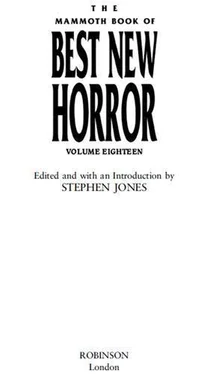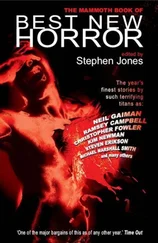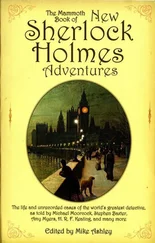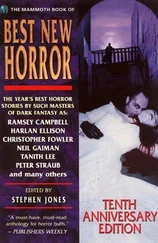Stephen (ed.) - The Mammoth Book of Best New Horror 18
Здесь есть возможность читать онлайн «Stephen (ed.) - The Mammoth Book of Best New Horror 18» весь текст электронной книги совершенно бесплатно (целиком полную версию без сокращений). В некоторых случаях можно слушать аудио, скачать через торрент в формате fb2 и присутствует краткое содержание. Жанр: Старинная литература, на английском языке. Описание произведения, (предисловие) а так же отзывы посетителей доступны на портале библиотеки ЛибКат.
- Название:The Mammoth Book of Best New Horror 18
- Автор:
- Жанр:
- Год:неизвестен
- ISBN:нет данных
- Рейтинг книги:3 / 5. Голосов: 1
-
Избранное:Добавить в избранное
- Отзывы:
-
Ваша оценка:
- 60
- 1
- 2
- 3
- 4
- 5
The Mammoth Book of Best New Horror 18: краткое содержание, описание и аннотация
Предлагаем к чтению аннотацию, описание, краткое содержание или предисловие (зависит от того, что написал сам автор книги «The Mammoth Book of Best New Horror 18»). Если вы не нашли необходимую информацию о книге — напишите в комментариях, мы постараемся отыскать её.
The Mammoth Book of Best New Horror 18 — читать онлайн бесплатно полную книгу (весь текст) целиком
Ниже представлен текст книги, разбитый по страницам. Система сохранения места последней прочитанной страницы, позволяет с удобством читать онлайн бесплатно книгу «The Mammoth Book of Best New Horror 18», без необходимости каждый раз заново искать на чём Вы остановились. Поставьте закладку, и сможете в любой момент перейти на страницу, на которой закончили чтение.
Интервал:
Закладка:
Last night I got drunk, more so than usual, a lot more so than usual, and watched it for the first time in almost a month. But I turned the sound on the television down all the way and left the lights burning.
Even drunk, I’m still a coward.
The ocean floor starkly illuminated by the ROV’s six 480-watt HMI lights, revealing a velvet carpet of grey-brown sediment washed out from Elkhorn Slough and all the other sloughs and rivers emptying into the bay. And even at this depth, there are signs of life: brittlestars and crabs cling to the shit-coloured rocks, sponges and sea cucumbers, the sinuous, smooth bodies of big-eyed rattails. Here and there, dark outcroppings jut from the ooze like bone from the decaying flesh of a leper.
My asshole editor would laugh out loud at that last simile, would probably take one look at it and laugh and then say something like, “If I’d wanted fucking purple I’d have bought a goddamn pot of violets.” But my asshole editor hasn’t seen the tape I bought from the tech.
My asshole editor never met Jacova Angevine, never listened to her talk, never fucked her, never saw the scars on her back or the fear in her eyes.
The ROV comes to a rocky place where the seafloor drops away suddenly, and it hesitates, responding to commands from the control room of the R/V Western Flyer. A moment or two later, the steady fall of marine snow becomes so heavy that it’s difficult to see much of anything through the light reflecting off the whitish particles of sinking detritus. And sitting there on the floor between the foot of the bed and the television, I almost reached out and touched the screen.
Almost.
“It’s a little bit of everything,” I heard Jacova say, though she never actually said anything of the sort to me. “Silt, phytoplankton and zooplankton, soot, mucus, diatoms, fecal pellets, dust, grains of sand and clay, radioactive fallout, pollen, sewage. Some of it’s even interplanetary dust particles. Some of it fell from the stars.”
And Tiburon II lurches and glides forward a few feet, then slips cautiously over the precipice, beginning the slow descent into this new and unexpected abyss.
“We’d been over that stretch more than a dozen times, at least,” Natalie Billington, chief ROV pilot for Tiburon II , told a CNN correspondent after the internet version of the tape first made the news. “But that drop-off wasn’t on any of the charts. We’d always missed it somehow. I know that isn’t a very satisfying answer, but it’s a big place down there. The canyon is over two hundred miles long. You miss things.”
For a while – exactly 15.34 seconds – there’s only the darkness and marine snow and a few curious or startled fish. According to MBARI, the ROV’s vertical speed during this part of the dive is about 35 meters per minute, so by the time it finds the bottom again, depth has increased by some five hundred and twenty-five feet. The sea-floor comes into view again, and there’s not so much loose sediment here, just a jumble of broken boulders, and it’s startling how clean they are, almost completely free of the usual encrustations and muck. There are no sponges or sea cucumbers to be seen, no starfish, and even the omnipresent marine snow has tapered off to only a few stray, drifting flecks. And then the wide, flat rock that is usually referred to as “the Delta stone” comes into view. And this isn’t like the face on Mars or Von Daniken seeing ancient astronauts on Mayan artifacts. The lowercase δ carved into the slab is unmistakable. The edges are so sharp, so clean that it might have been done yesterday.
The Tiburon II hovers above the Delta stone, spilling light into this lightless place, and I know what’s coming next, so I sit very still and count off the seconds in my head. When I’ve counted to thirty-eight, the view from the ROV’s camera pans violently to the right, signaling the portside impact, and an instant later there’s only static, white noise, the twelve-second gap in the tape during which the camera was still running, but no longer recording.
I counted to eleven before I switched off the television, and then sat listening to the wind, and the waves breaking against the beach, waiting for my heart to stop racing and the sweat on my face and palms to dry. When I was sure that I wasn’t going to be sick, I pressed EJECT and the VCR spat out the tape. I returned it to its navy-blue plastic case and sat smoking and drinking, helpless to think of anything but Jacova.
IV
Jacova Angevine was born and grew up in her father’s big Victorian house in Salinas, only a couple of blocks from the birthplace of John Steinbeck. Her mother died when she was eight. Jacova had no siblings, and her closest kin, paternal and maternal, were all back east in New Jersey and Pennsylvania and Maryland. In 1960, her parents relocated to California, just a few months after they were married, and her father took a job teaching high-school English in Castroville. After six months, he quit that job and took another, with only slightly better pay, in the town of Soledad. Though he’d earned a doctorate in comparative literature from Columbia, Theo Angevine seemed to have no particular academic ambitions. He’d written several novels while in college, though none of them had managed to find a publisher. In 1969, his wife five months pregnant with their daughter, he resigned from his position at Soledad High and moved north to Salinas, where he bought the old house on Howard Street with a bank loan and the advance from his first book sale, a mystery novel titled The Man Who Laughed at Funerals (Random House; New York).
To date, none of the three books that have been published about Jacova, the Open Door of Night sect, and the mass drownings off Moss Landing State Beach, have made more than a passing mention of Theo Angevine’s novels. Elenore Ellis-Lincoln, in Closing the Door: Anatomy of Hysteria (Simon and Schuster; New York), for example, devotes only a single paragraph to them, though she gives Jacova’s childhood an entire chapter. “Mr Angevine’s works received little critical attention, one way or the other, and his income from them was meager,” Ellis-Lincoln writes. “Of the seventeen novels he published between 1969 and 1985, only two – The Man Who Laughed for Funerals [sic] and Seven at Sunset – are still in print. It is notable that the overall tone of the novels becomes significantly darker following his wife’s death, but the books themselves never seem to have been more to the author than a sort of hobby. Upon his death, his daughter became the executor of his literary estate, such as it was.”
Likewise, in Lemming Cult (The Overlook Press; New York), William L. West writes, “Her father’s steady output of mystery and suspense potboilers must surely have been a curiosity of Jacova’s childhood, but were never once mentioned in her own writings, including the five private journals found in a cardboard box in her bedroom closet. The books themselves were entirely unremarkable, so far as I’ve been able to ascertain. Almost all are out of print and very difficult to find today. Even the catalog of the Silinas Public Library includes only a single copy each of The Man Who Laughed at Funerals, Pretoria , and Seven at Sunset .”
During the two years I knew her, Jacova only mentioned her father’s writing once that I can recall, and then only in passing, but she had copies of all his novels, a fact that I’ve never seen mentioned anywhere in print. I suppose it doesn’t seem very significant, if you haven’t bothered to read Theo Angevine’s books. Since Jacova’s death, I’ve read every one of them. It took me less than a month to track down copies of all seventeen, thanks largely to online booksellers, and even less time to read them. While William West was certainly justified in calling the novels “entirely unremarkable,” even a casual examination reveals some distinctly remarkable parallels between the fiction of the father and the reality of the daughter.
Читать дальшеИнтервал:
Закладка:
Похожие книги на «The Mammoth Book of Best New Horror 18»
Представляем Вашему вниманию похожие книги на «The Mammoth Book of Best New Horror 18» списком для выбора. Мы отобрали схожую по названию и смыслу литературу в надежде предоставить читателям больше вариантов отыскать новые, интересные, ещё непрочитанные произведения.
Обсуждение, отзывы о книге «The Mammoth Book of Best New Horror 18» и просто собственные мнения читателей. Оставьте ваши комментарии, напишите, что Вы думаете о произведении, его смысле или главных героях. Укажите что конкретно понравилось, а что нет, и почему Вы так считаете.











